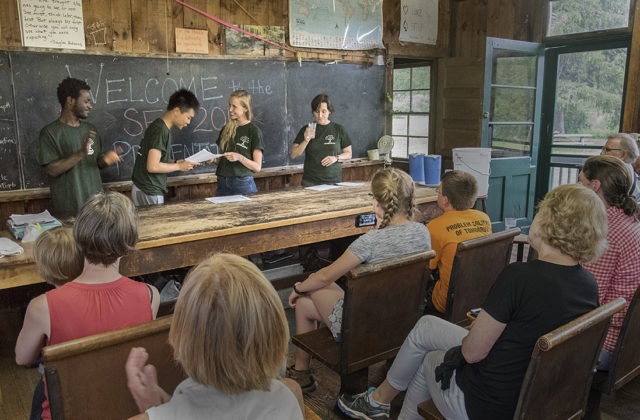Christodora Program Brings City Youth to Study in Great Mountain Forest
Trading Cell Phones for Compasses
By Susan MacEachron
Is there a correlation between the density of hay-scented fern and the tick population? How do soil conditions affect the growth of Late Low blueberries? What is the impact of environmental conditions on the red eft, which is the orange, land-dwelling, juvenile stage of the eastern newt?
Twelve young scientists from New York City spent the past two weeks living and working at the Yale School of Forestry Camp in the Great Mountain Forest. The program is run by a nonprofit organization, Christodora, whose mission is to encourage academic and developmental growth of New York City youth through educational and challenging outdoor programs.
The Summer Ecology Program at GMF encourages the students to explore forest ecosystems by designing and conducting a research project, testing their hypotheses using scientific techniques and making experiment-based discoveries. For more than 20 years, Christodora students have been coming to GMF, whose mission is to promote the working forest as a renewable resource, a habitat for wildlife and a classroom for training and education.
The four high school students who focused their research on tick population studies called themselves the Tick Busters. Their approach was to pull a drag of white fabric across different 10 x 10-meter sites, each with different degrees of fern density, to catch and then count the ticks. Their hypothesis was that the denser the fern growth, the better protection for field mice and therefore more ticks—since mice serve as hosts. While they failed to prove that hypothesis, since there appeared to be no correlation between the density of the ferns and the number of ticks, they did discover a correlation with the height of the ferns: as fern height increased, so did the number of ticks.
Another team explored the relationship between blueberry vitality and the various features of the forest ecology, such as elevation, soil content and moisture. A third team searched for red efts and studied the eastern newt’s navigation across the forest floor. All the teams gave a final presentation to the entire group in which they described what they had learned and suggested further avenues for research.
The 12 students, who hail from several different New York City schools, were united by their interest in science and the courage to tackle new adventures. For most, this was their first experience living and working in the woods. The Christodora counselors collect cell phones at the start of the program, and except for an occasional call home, the students are unplugged and living in the forest for two weeks.
Star Childs spent a half day with the students, teaching them how to use a compass and how to determine the declination between magnetic north and true north. The students then headed off into dense woods, trusting that with compass in hand they could get back to the starting point. This exercise, what foresters would call an open forest traverse, fosters teamwork and trust.
One of the students, Mahnoor Sheikh, admitted that “the forest didn’t get the memo, and trees would be in the middle of the path we were charting, which put us off course, so we didn’t end up exactly where we had started.” She also expressed delight at how the instructors, when walking through the woods with trees all around, would call the group’s attention to one particular tree, describing why it was special.
Another student, Ryan Hernandez, said the experience took him out of his comfort zone, but by the end of two weeks he really didn’t want to return to the city. He had also discovered that he didn’t need his cell phone as much as he had thought.
Photo by Bruce Frisch.

